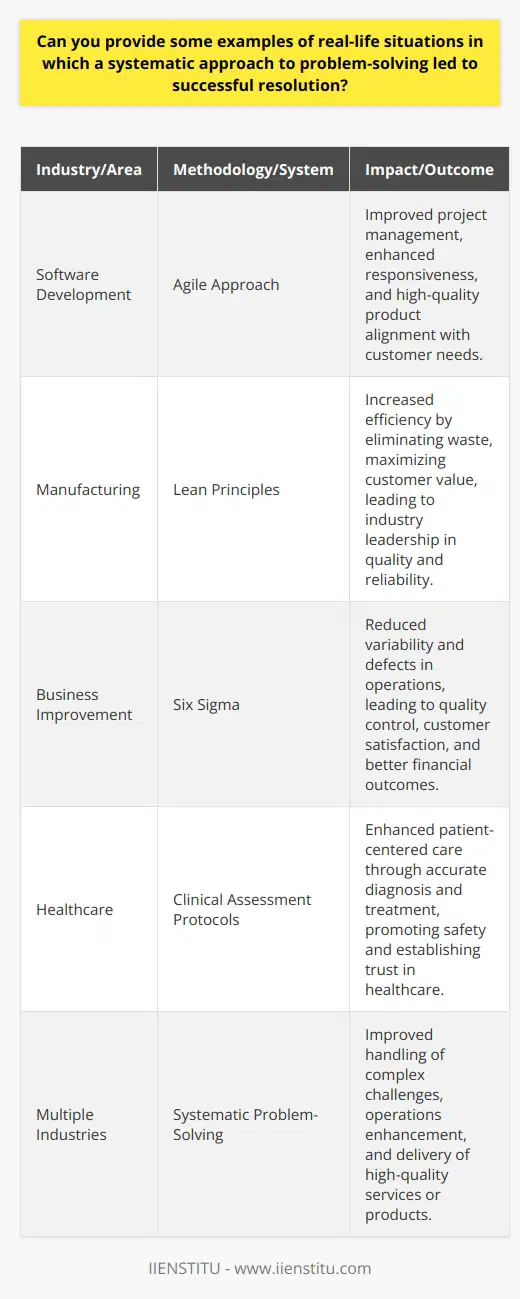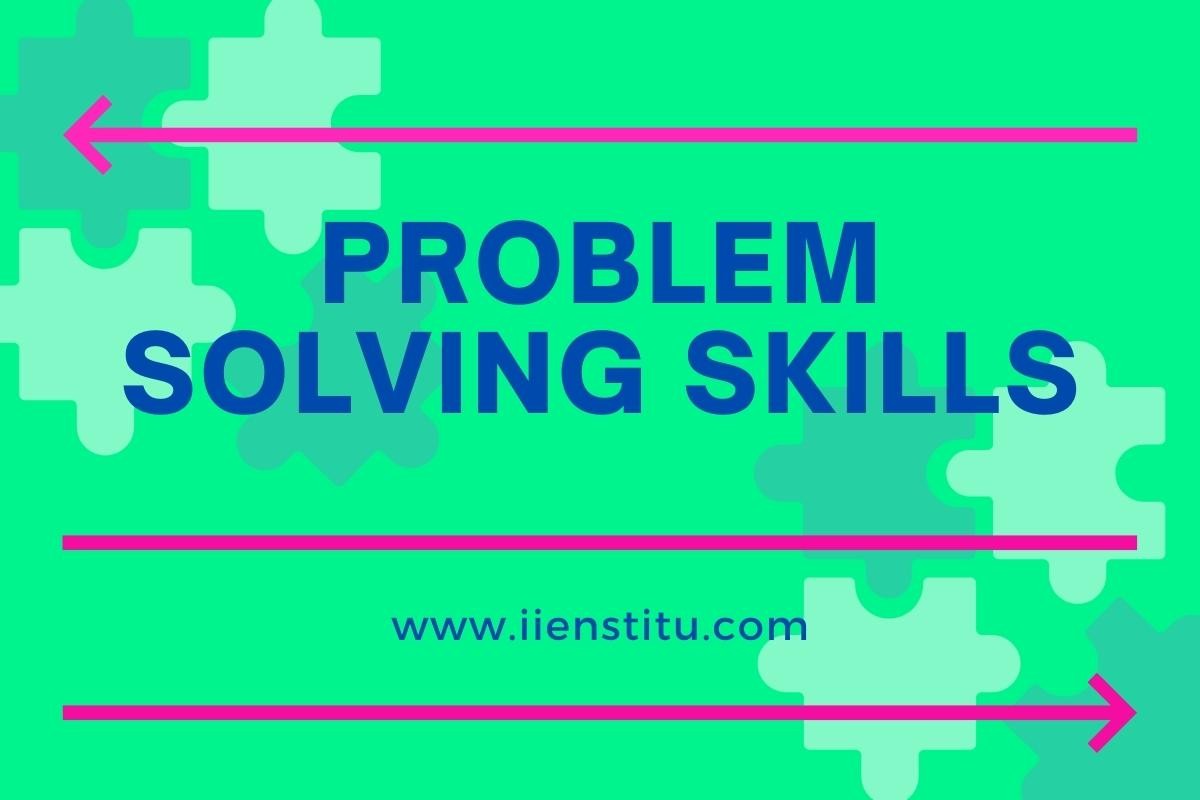
This article discusses the importance of accuracy when problem-solving and how it can affect the success of finding a solution. It examines the differences between excellent and poor problem solvers and discusses how to become a better problem solver.
Good problem solvers take the time to understand the facts and relationships in a problem thoroughly and accurately. They are willing to go back and reread the problem if they are not sure they have understood it correctly. On the other hand, poor problem solvers may lack the patience and attention to detail necessary for successful problem-solving.
Introduction
The Importance of Accuracy
Examining the Problem
Poor Problem Solvers
Conclusion
Introduction: Problem solving is an essential skill in many areas of life, including academics, work, and personal relationships. It requires a person to have a deep understanding of the facts and relationships involved in a problem and to be able to identify the problem and come up with a solution accurately.
Good problem solvers take great care to understand the facts and relationships in a problem thoroughly and accurately. In contrast, poor problem solvers often lack an intense concern about understanding the problem.
This article will explore the importance of accuracy when problem-solving, examine the issues that poor problem-solvers face, and discuss how to become better problem-solvers.
The Importance of Accuracy
Good problem solvers take great care to understand the facts and relationships in a problem thoroughly and accurately, and they are almost compulsive in checking whether their understanding of a problem is correct and complete. By contrast, poor problem solvers generally lack such an intense concern about performance.
For example, good problem solvers sometimes reread a problem several times until they are sure they understand it, while poor problem solvers often miss a problem because they do not know precisely what it states.
Quite often, they could have found out if they had been more careful if they had reexamined and thought about the problem analytically. But poor problem solvers have not learned how important it is to try to be completely accurate in understanding all of the ideas of a problem.
Examining the Problem
When problem-solving, it is essential to take the time to examine the problem and all of its components. This means taking the time to read the situation carefully and consider all the details. It also means thinking about the problem from different angles and feeling all possible solutions.
Good problem solvers take the time to analyze the situation and its components, and they are willing to go back and reread the problem if they are not sure they have understood it correctly.
Poor Problem Solvers

Poor problem solvers often lack the patience and attention to detail that good problem solvers have. They may not take the time to read the problem carefully or think about it from different angles.
In addition, they may not realize how important accuracy is when problem-solving, and they may not take the time to reread the problem if they are not sure they have understood it correctly. Poor problem solvers may also be more likely to give up on a problem if they have difficulty understanding it rather than working through it.
Example: A Failed Business Venture
Imagine a small business owner launching a new product without conducting adequate market research or thoroughly analyzing competitors. Driven by enthusiasm rather than careful planning, the owner neglects to take the time to understand the target audience, pricing strategy, or how the product fits into the existing market landscape.
The lack of attention to detail and impatience in the planning stage leads to the business launching the product at the wrong price point and targeting an audience that's not interested in the offering. Competitors with similar products quickly outpace the business, as they have understood the market dynamics better.
Additionally, when initial sales are disappointing, the business owner may become quickly discouraged and give up on the product without seeking to understand what went wrong. Rather than reevaluating the situation, analyzing the failed strategy, or even re-reading market reports, they abandon the project entirely.
In this real-life scenario, the poor problem-solving skills exhibited include a lack of thorough examination of the problem (in this case, successful product launch), an absence of attention to crucial details such as pricing and audience targeting, and a lack of persistence in working through difficulties. This approach leads to a failed business venture, showcasing the significant consequences of poor problem-solving in a tangible and relatable way.
Specific Examples of Poor Problem-Solving Behavior and Consequences

By illustrating the difference between good and poor problem-solving techniques with real-world examples, you can make the concept more tangible for readers. Here's a sample addition that could be inserted into the section on poor problem solvers:
For example, consider a team working on a complex project with tight deadlines. A poor problem solver might gloss over critical details in the initial planning phase, resulting in unforeseen challenges later on. This could lead to delays, increased costs, or even the failure of the project. On the other hand, a good problem solver in the same situation would carefully analyze all the aspects of the project, creating a well-thought-out plan that addresses potential issues before they become problems.
Adding a Section on Common Strategies
A section providing readers with tangible strategies to improve their problem-solving skills could be invaluable. Here's a possible subsection:
Strategies to Enhance Problem-Solving Skills
Identify Key Information: Break the problem into smaller parts and highlight the essential details. Write them down to have a clear picture.
Analyze Relationships: Understand how different elements of the problem are connected and how they influence one another.
Test Solutions: Before implementing a solution, run it through a series of tests to ensure that it is accurate and effective.
Learn from Mistakes: Reflect on past errors in problem-solving to understand what went wrong and how to avoid similar mistakes in the future.
Real-Life Scenarios or Case Studies
Real-life scenarios or case studies could also add depth and practical value to the article. Here's an example that could be added:
Case Study: The Medical Diagnosis
A patient was misdiagnosed due to the doctor's lack of attention to details in the symptoms and medical history. This error led to the wrong treatment and further health complications. Later, a more thorough examination by another physician, who paid careful attention to the patient's symptoms and previous health records, led to the correct diagnosis and appropriate treatment. This case highlights the importance of accuracy and attention to detail in problem-solving, even in life-or-death situations.
By incorporating these elements, the article would offer a more comprehensive and engaging perspective on the subject. The readers would not only understand the theoretical aspects of accurate problem-solving but also see how these principles can be applied in various real-world contexts.
Accuracy is an essential factor when it comes to problem-solving. Good problem solvers take great care to understand the facts and relationships in a problem thoroughly and accurately. They are willing to go back and reread the problem if they are not sure they have understood it correctly.
On the other hand, poor problem solvers often lack an intense concern about understanding the problem, and they may not take the time to reread the problem if they are not sure they have understood it correctly. One can become a better problem solver by understanding the importance of accuracy and taking the time to examine the situation and its components.
In problem-solving, accuracy is paramount; precision is the key to success.
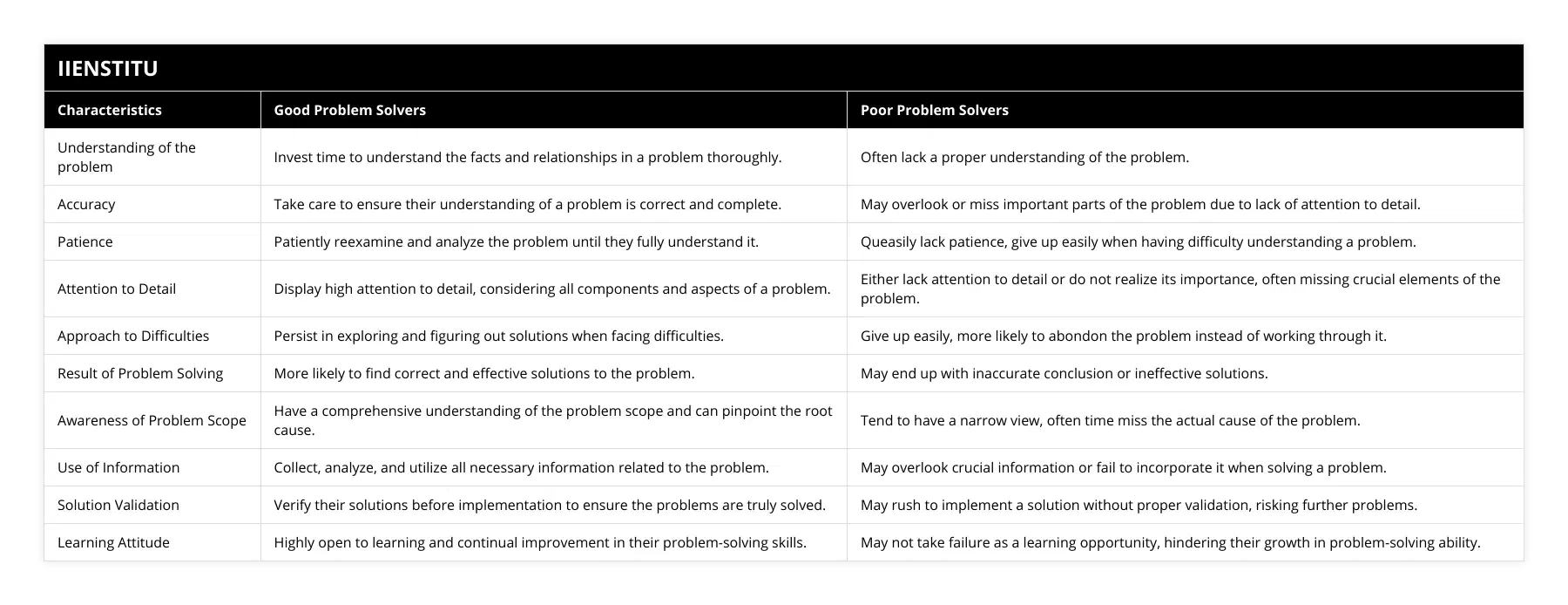
Frequently Asked Questions
What strategies can be used to develop accurate problem solving skills?
Problem-solving is essential for success in many areas of life, from work to personal relationships. Developing fundamental problem-solving skills can help individuals identify and resolve issues more efficiently and effectively. This article will explore several strategies that can be used to create accurate problem-solving skills.
First, it is essential to understand the nature of the problem. This requires identifying the underlying causes of the issue and understanding how these factors interact to create the problem. Individuals can gain a clearer understanding of the problem and develop a more effective solution by taking the time to assess the situation thoroughly.
Second, individuals should practice active listening during problem-solving conversations. This requires paying attention to the other person’s point of view and understanding their perspective. By listening carefully, individuals can gain insight into the other person’s perspective and develop a better solution.
Third, individuals should strive to be open-minded and flexible when problem-solving. This involves considering different perspectives and being willing to accept new ideas. Individuals can identify more creative and effective solutions by being open to other solutions.
Fourth, individuals should use critical thinking to evaluate potential solutions. This involves examining the pros and cons of different solutions and considering the long-term implications of considering each option. Individuals can develop a more accurate answer by taking the time to evaluate the options carefully.
Finally, individuals should be willing to take risks and experiment with different solutions. This requires individuals to step outside their comfort zone and try something new. Individuals can discover new solutions and develop problem-solving skills by taking risks.
In conclusion, developing fundamental problem-solving skills requires understanding the nature of the problem, practicing active listening, being open-minded and flexible, using critical thinking, and being willing to take risks. By utilizing these strategies, individuals can develop more effective problem-solving skills and identify and resolve issues more efficiently and effectively.
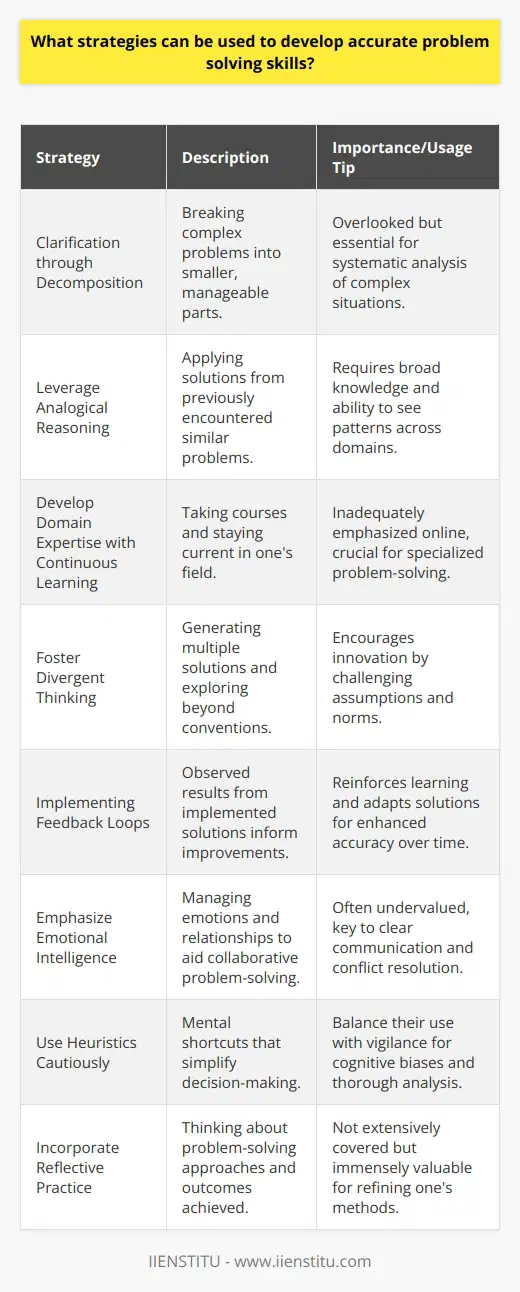
How can one identify and address errors in problem solving?
Problem-solving is essential in many fields, from mathematics to engineering. However, problem-solving errors can make it challenging to identify and address them. In this article, we will discuss how to identify and address errors in problem-solving.
The first step in identifying errors in problem-solving is understanding the basic principles. This includes understanding the problem, breaking it down into manageable pieces, and finding a solution. Once the basics are understood, it is essential to identify and assess any potential errors. This can be done by analyzing the data and reasoning used in the problem-solving process and checking the results of the solution to ensure accuracy.
Once errors have been identified, it is essential to address them systematically. This can include re-examining the data and the reasoning used, as well as re-evaluating the results of the solution. If the errors are related to the data or reason, it is essential to identify the source and take corrective action. On the other hand, suppose the errors are related to the results. In that case, it is necessary to determine if an alternate solution can be found or if the initial solution needs to be modified to achieve the desired outcome.
Finally, reviewing the problem-solving process and making any necessary changes to address errors is essential. This can include identifying and addressing any assumptions made in the problem-solving process and ensuring that the data and reasoning used are appropriate for the problem. Additionally, it is essential to review the solution's results to ensure accuracy periodically.
In conclusion, identifying and addressing errors in problem-solving is a critical skill that can improve the quality of the solutions. By understanding the basic principles of problem-solving, analyzing the data and reasoning used, and taking corrective action when necessary, it is possible to identify and address errors in problem-solving.
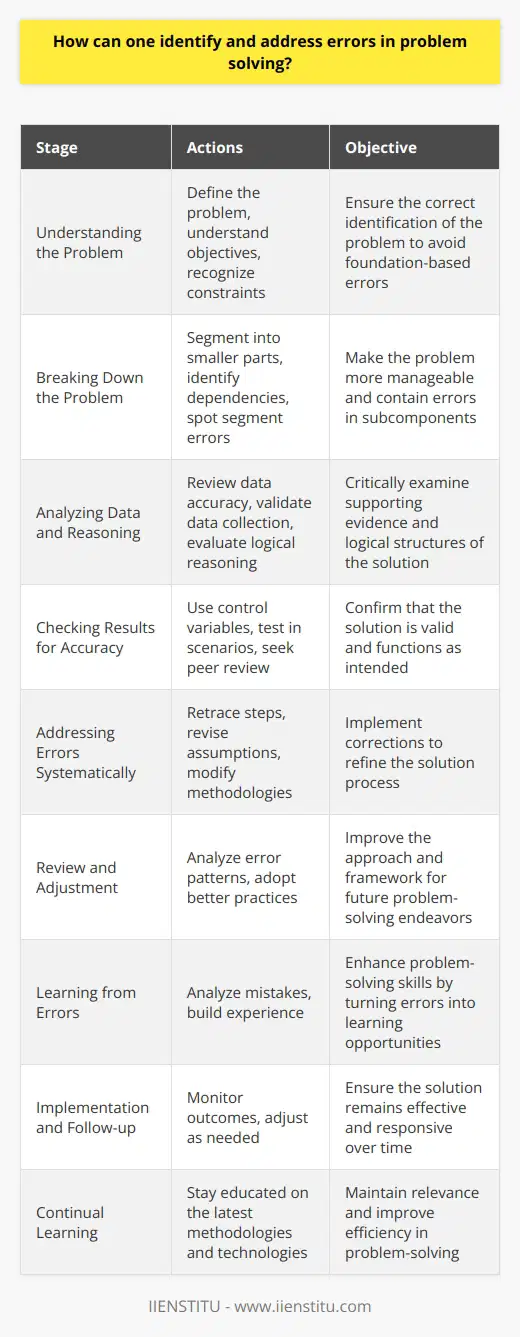
What are the benefits of developing accurate problem solving skills?
Problem-solving skills are essential for success in any field, whether it be professional or personal. A person's ability to accurately identify issues and develop solutions is critical to achieving goals and overcoming obstacles. Creating accurate problem-solving skills has many benefits, from improved decision-making to increased productivity.
One of the primary benefits of developing fundamental problem-solving skills is improved decision-making. Understanding the problem and its potential solutions makes a person better equipped to make informed decisions. In addition, real mental problem-solving makes a person more likely to select the best action, leading to more successful outcomes.
Accurate problem-solving skills also lead to increased productivity. By accurately identifying problems, a person can quickly and efficiently develop solutions. This saves time and resources and allows for completing tasks in a shorter amount of time.
In addition, developing fundamental problem-solving fundamental skills can help to improve a person's ability to think critically. A person who can accurately identify and solve problems is more likely to be able to think outside the box and come up with innovative solutions. This can lead to more creative solutions that may not have been considered.
Finally, developing fundamental problem-solving skills can help to reduce stress. By accurately identifying problems and quickly developing solutions, a person is less likely to worry and stress over issues they cannot solve. This can lead to improved mental well-being and a healthier outlook on life.
In conclusion, developing fundamental problem-solving skills is beneficial for many reasons. There are numerous advantages to having a well-honed problem-solving ability, from improved decision-making to increased productivity. Additionally, it can help to reduce stress and enhance critical thinking. For these reasons, developing and honing fundamental problem-solving skills is essential.
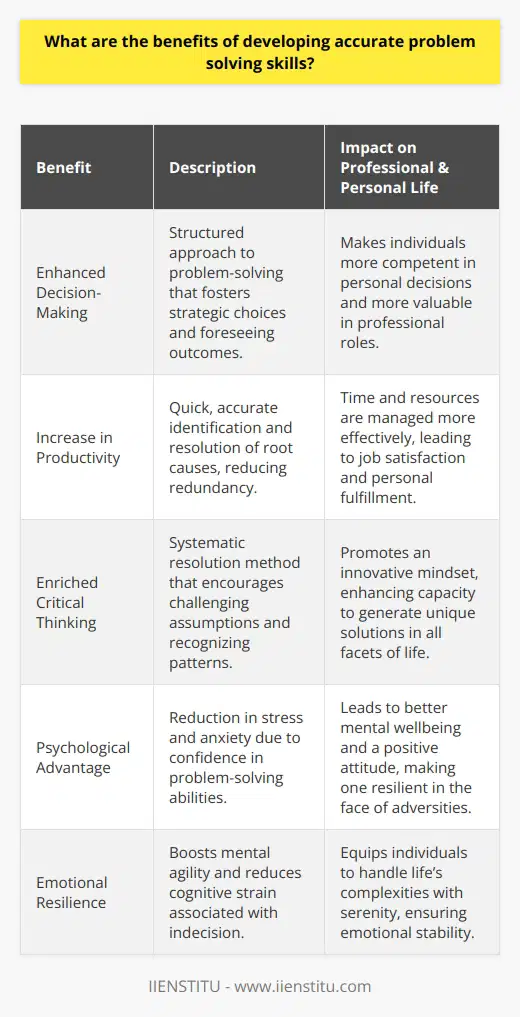
What are the essential components of effective problem-solving methods?
**Understanding the Problem**
Effective problem-solving methods begin with comprehending the issue at hand. Identifying the root cause of a problem enables individuals to find suitable solutions, preventing potential misunderstandings and misdirection.
**Gathering Relevant Information**
Collecting data related to the problem is another critical component. Gathering relevant information ensures that any decisions made are evidence-based and grounded in facts, ultimately resulting in more successful problem-solving outcomes.
**Exploring Various Approaches**
Considering multiple perspectives and applying diverse strategies when tackling problems promote balanced and comprehensive solutions. By analyzing different angles and techniques, individuals can adapt to various contexts and tackle each challenge as effectively and efficiently as possible.
**Generating Potential Solutions**
Brainstorming plays a fundamental role in problem-solving, as it encourages individuals to think creatively and propose a wide range of options. This stage allows for the exploration of various potential solutions before settling on the most appropriate one.
**Evaluating and Selecting Solutions**
Logical reasoning is essential for assessing the viability and feasibility of each proposed solution. Evaluation involves weighing the pros and cons, gauging the overall effectiveness, and determining the best course of action. This step ensures that the selected solution is most likely to address the problem successfully.
**Implementing the Chosen Solution**
After selecting the most fitting solution, the next component of effective problem-solving is its implementation. This stage entails putting the chosen approach into practice and actively working toward resolving the issue at hand. Monitoring progress and making necessary adjustments ensure the problem-solving method's success.
**Reflecting on the Process and Outcome**
The final component of effective problem-solving is reflecting on both the process and the outcome. Assessing how well the solution worked, considering what could have been done differently, and learning from the experience allow for continuous improvement and skill development as individuals encounter future challenges.
In conclusion, effective problem-solving methods encompass understanding the problem, gathering pertinent information, employing various approaches, generating potential solutions, evaluating and selecting the best course of action, implementing the chosen solution, and reflecting on the process and outcome. By incorporating these components, individuals are better equipped to tackle challenges and find efficient and successful resolutions.
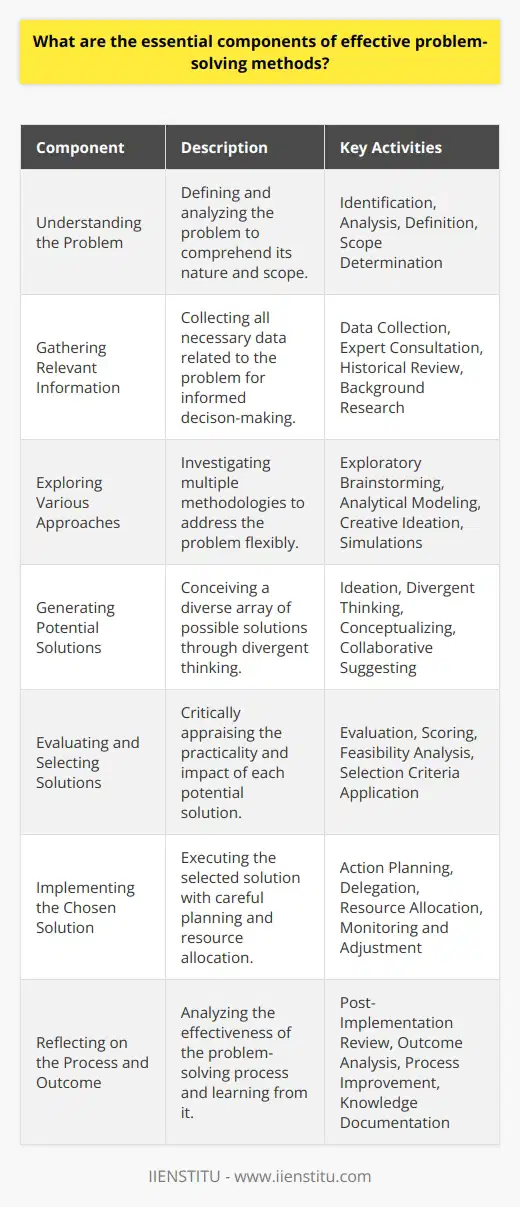
In what ways can individuals improve their critical thinking skills to enhance problem-solving abilities?
Developing Critical Thinking Skills
One way individuals can improve their critical thinking skills is through continuous learning and self-education. This entails reading broadly, attending courses or workshops, and engaging in stimulating discussions with diverse groups of people to gain new insights and perspectives on various issues. Additionally, embracing intellectual curiosity and asking questions can inspire deeper understanding and facilitate creative thinking and problem-solving abilities.
Practicing Active Listening
Active listening is another essential skill that can strengthen critical thinking. By genuinely paying attention to others' viewpoints and asking relevant follow-up questions, one can improve their comprehension, discern underlying motives, and consider alternative ideas that may have otherwise gone unexplored. Moreover, it encourages open-mindedness and humility, key qualities for strong critical thinkers.
Cultivating Analytical Abilities
To enhance problem-solving capabilities, individuals should cultivate their analytical abilities. This involves breaking down complex issues and situations into simple, manageable components. By systematically examining each element, one can gain a clearer understanding of the issue at hand and effectively formulate and evaluate possible solutions. Posing thoughtful questions, seeking relevant evidence, and identifying assumptions and biases can further improve analytical thinking.
Employing Logical Reasoning
Another method to sharpen critical thinking skills is through the practice of logical reasoning. This includes understanding the relationships between different ideas and deducing reasonable conclusions from available information. Individuals can engage in activities such as puzzles, debates, and analyzing arguments to hone their logical thinking abilities. By consistently applying logic to everyday situations, individuals can increase their awareness of potential pitfalls in their thinking processes and improve decision-making capabilities.
Reflecting on Personal Biases
Finally, recognizing and addressing personal biases are crucial elements in developing critical thinking skills. Individuals can improve their problem-solving abilities by routinely reflecting on their thought processes and recognizing instances when their opinion may have been clouded by preconceived notions, emotions, or other factors. By acknowledging and adjusting these biases, individuals can approach problem-solving from a more objective standpoint, enhancing their critical thinking skills in the process.
In conclusion, there are multiple ways individuals can improve their critical thinking skills to enhance problem-solving abilities. Through continuous learning, active listening, cultivating analytical abilities, employing logical reasoning, and reflecting on personal biases, individuals can become more effective critical thinkers and problem solvers.
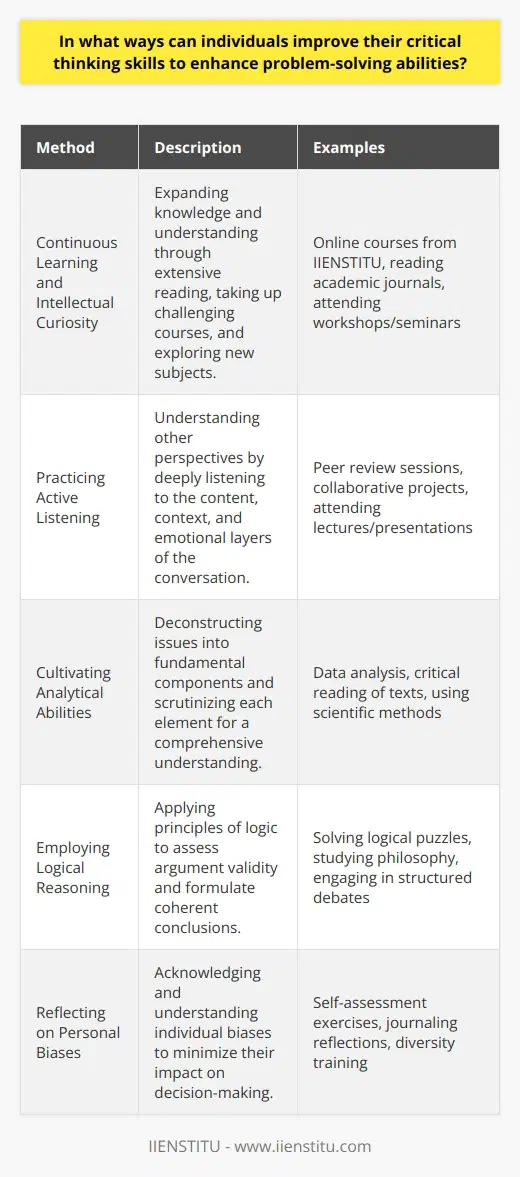
How can collaborative and interdisciplinary approaches contribute to more effective problem-solving?
Collaborative Strategies
Collaborative and interdisciplinary approaches play a crucial role in supporting more effective problem-solving techniques. By working collaboratively, individuals from various fields can share expertise, resources, and insights, thereby allowing for a comprehensive understanding of diverse perspectives. Additionally, the pooling of specialized knowledge fosters collective decision-making and drives innovation, leading to the development of sustainable solutions.
Synergy through Interdisciplinarity
When professionals from different disciplines team up, they create an interdisciplinary environment that promotes synergy in finding new and effective solutions. Interdisciplinary collaboration enhances creativity and generates more innovative ideas as it merges various scientific and cultural backgrounds, leading to the formulation of unique insights. Consequently, interdisciplinary approaches enable the exploration of complex socioeconomic and technological challenges, such as climate change, public health crises, and technological advancements, more effectively.
Knowledge Integration
One of the main strengths of interdisciplinary collaboration lies in how it enables the generation and utilization of superior ideas by integrating various forms of knowledge. Research outputs from these collaborations often lead to the development of novel theoretical frameworks and groundbreaking methodologies. Furthermore, interdisciplinary collaboration encourages the re-evaluation of previously held concepts and generates fresh perspectives on well-established issues, promoting evidence-based solutions and informed decision-making.
Effective Communication Skills
Collaborative and interdisciplinary approaches depend largely on efficient communication channels between team members. Developing and maintaining open lines of communication is essential to ensure that all perspectives are heard and considered when tackling complex problems. Training professionals in communication skills that facilitate collaboration will promote the efficient sharing of knowledge and ideas, leading to more effective problem-solving.
In conclusion, collaborative and interdisciplinary approaches contribute significantly to more effective problem-solving in various fields of study. By fostering open communication channels, interdisciplinary collaborations result in rich intellectual exchanges, enabling collaborative teams to generate innovative solutions to pressing global challenges. Ultimately, these approaches facilitate the integration of specialized knowledge, leading to transformative discoveries and more informed decision-making processes.
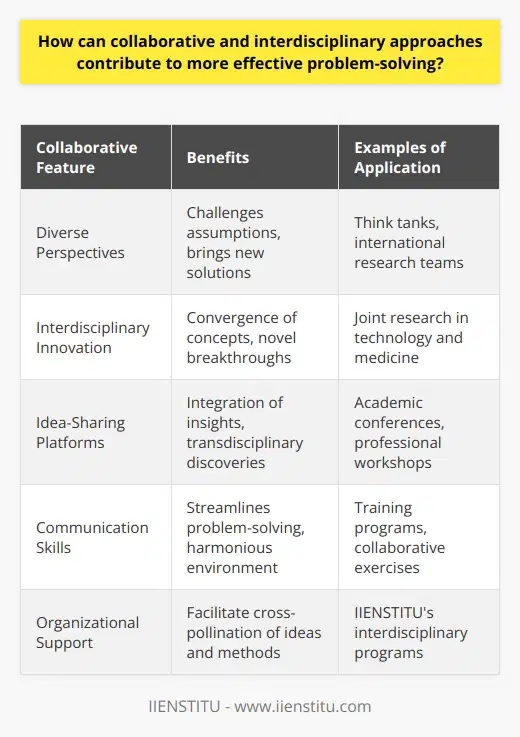
How are you developing your problem-solving skills?
**Engaging in Diverse Learning Strategies**
In order to develop my problem-solving skills, I have continually engaged in diverse learning strategies. By actively participating in educational opportunities such as workshops, online courses, and seminars, I have acquired a deeper understanding of various problem-solving techniques. This has allowed me to adapt my approach depending on the specific challenge at hand, ultimately enhancing my ability to effectively analyze and find solutions to complex problems.
**Collaborating with Peers and Experts**
Another key aspect of my problem-solving skill development involves collaborating with peers and experts in various fields. Through this collaborative process, I have exposed myself to innovative perspectives, ideas, and potential solutions to problems. By working together and engaging in effective communication, we are able to brainstorm, critically analyze, and derive optimal solutions to problems that may be difficult to tackle individually.
**Implementing Reflective Practices**
Reflective practices are fundamental in fostering problem-solving skills. By regularly reflecting on my experiences, decisions, and outcomes, I am able to assess my strengths and weaknesses in problem-solving. This self-assessment provides valuable insight into areas that require further growth and improvement. Additionally, it increases self-awareness and assists in the development of critical thinking, enabling me to better adapt and approach future challenges with a deeper understanding of my capabilities and potential strategies.
**Applying Knowledge to Real-life Situations**
Transferring the knowledge and skills acquired from diverse learning strategies and collaborative experiences into real-life situations is essential for effective problem-solving skill development. By actively seeking and embracing opportunities to apply these skills in real-world contexts, I am able to evaluate their practicality and efficiency. This hands-on experience strengthens my problem-solving ability and provides a solid foundation for continuous growth and development in this vital skillset.
**Perseverance and Resilience in the Face of Challenges**
Developing problem-solving skills requires perseverance and resilience in the face of challenges. In order to efficiently build these skills, I strive to maintain a growth mindset and view setbacks as opportunities for learning and growth. This mindset allows me to remain persistent and stay committed to enhancing my problem-solving skills, despite any obstacles or difficulties that may arise.
In conclusion, by engaging in diverse learning strategies, collaborating with peers and experts, implementing reflective practices, applying knowledge to real-life situations, and maintaining perseverance and resilience, I continually develop and strengthen my problem-solving skills. This comprehensive approach ensures not only the effective growth of my problem-solving capabilities but also contributes to my overall personal and professional development.
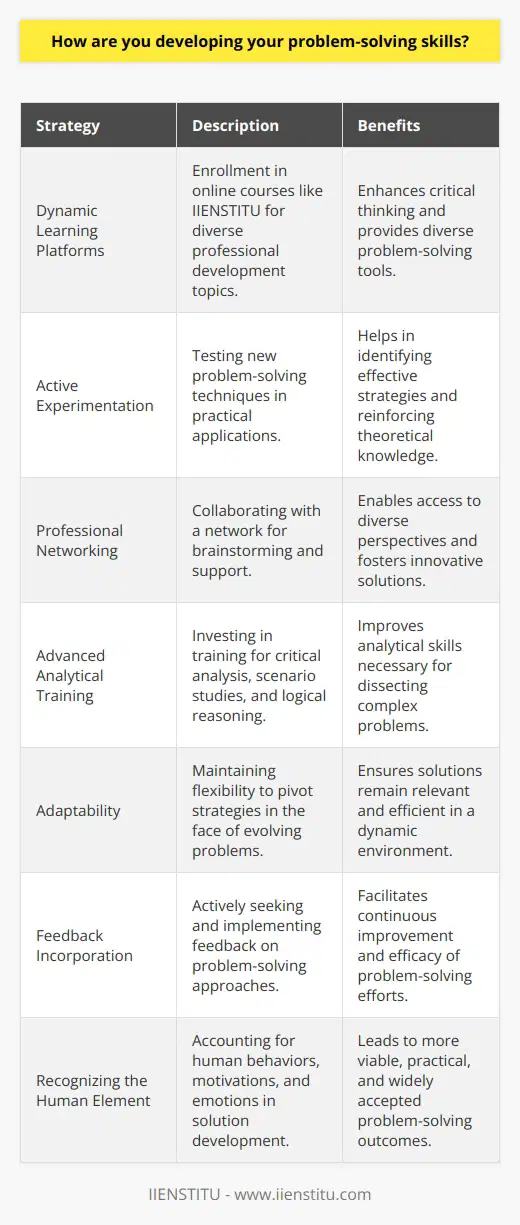
What does developing problem-solving skills mean?
Developing Problem-Solving Skills: Definition and Importance
Developing problem-solving skills entails acquiring and refining the ability to approach complex situations, analyze information, and determine effective solutions. This process requires critical thinking, creativity, and adaptability, as well as strong observational and analytical abilities. These skills are invaluable across various aspects of life, including personal, academic, and professional contexts.
Key Components of Problem-Solving
Critical thinking forms the backbone of problem-solving, requiring individuals to objectively assess information, evaluate potential outcomes, and choose the best course of action. Creativity, on the other hand, allows individuals to explore diverse perspectives and generate unique ideas or solutions. Strong observational and analytical abilities are crucial for recognizing patterns, connecting pieces of information, and deducing possible resolutions. Additionally, adaptability is a necessary component, as it enables people to revise their strategies when faced with changing circumstances or newly acquired information.
Benefits in Personal Life
In one's personal life, refined problem-solving abilities lead to better decision-making and can contribute to overall well-being. These skills enable individuals to navigate an array of challenges, ranging from interpersonal conflicts to time management and financial planning. As a result, people with strong problem-solving skills may experience reduced stress levels and improved life satisfaction.
Perks in Academic and Professional Domains
Academically, problem-solving skills support higher-order thinking, facilitating the absorption of complex concepts and the completion of assignments or projects. In professional settings, individuals who demonstrate adept problem-solving abilities are often more productive, efficient, and effective in their roles. Mastery of these skills is vital for career advancement, as employers increasingly prioritize candidates with strong problem-solving capabilities.
Developing these skills is a lifelong process, involving intentional effort in cultivating critical thinking, creativity, observation/analysis, and adaptability. Continuous refinement of problem-solving abilities will yield significant personal, academic, and professional benefits. Ultimately, improving these skills can enhance one's overall quality of life and contribute to success across numerous domains.
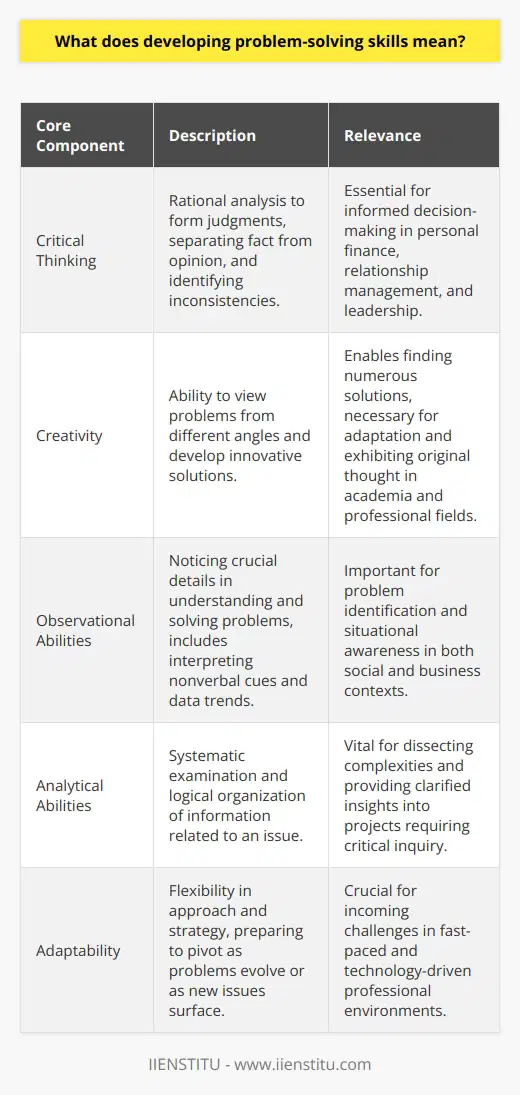
What are the 3 skills to solve problems effectively?
Analytical Skills
The first skill to effectively solve problems is the development of strong analytical capabilities. These involve the ability to examine a situation or problem, identify various aspects and components, and discern relationships between them. Mastering analytical skills enables an individual to break down complex problems into smaller, more manageable parts, then piece together possible solutions.
Critical Thinking
The second essential skill in problem solving is critical thinking, which involves the application of logic and reasoning to assess the value of information and ideas. This skill allows individuals to evaluate available alternatives, weigh the evidence, and make informed decisions based on the credibility and relevance of the information. Critical thinking is necessary for identifying the most effective solution to a problem, as it facilitates the ability to recognize underlying biases, assumptions, and logical fallacies that may inhibit arriving at the right answers.
Creativity and Adaptability
Lastly, solving problems effectively requires creativity and adaptability. Creative problem-solving approaches push individuals to think laterally and consider innovative or unconventional ways of addressing challenges. This skill is particularly important in today's rapidly changing world, as it allows one to adapt to new circumstances and devise solutions that address evolving issues. Meanwhile, adaptability refers to the ability to adjust and modify one's approach based on changing contexts and outcomes. Combining creativity and adaptability ensures that problem-solvers can select the most suitable approach for the specific problem at hand, resulting in faster and more effective resolutions.
In conclusion, the three key skills vital to problem-solving effectively are analytical skills, critical thinking, and a combination of creativity and adaptability. Mastering these skills allows individuals to approach and resolve problems systematically, logically, and innovatively, increasing the likelihood of success in various personal and professional endeavors.
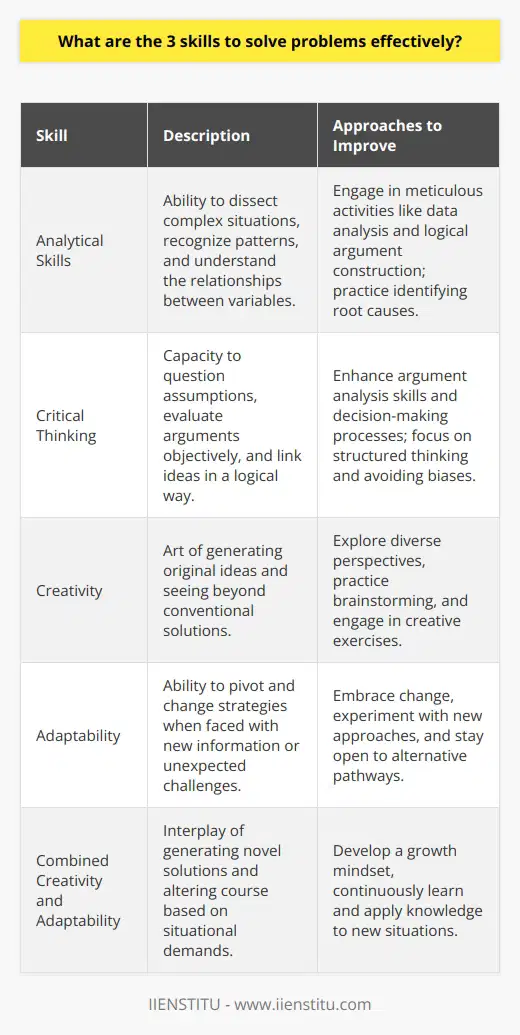
What are the 7 steps for an effective problem-solving process?
Understanding the Problem-Solving Process
To achieve successful problem-solving, a systematic approach consisting of seven steps is highly encouraged. Each step plays an important role in providing a comprehensive and efficient strategy to tackle any problem faced.
Identifying the Problem
The first step involves pinpointing the exact issue that needs to be resolved, which enables individuals to better understand the root cause of the problem and set clear objectives.
Defining the Problem
Once the problem is identified, it must be accurately defined and described. This involves breaking down the issue into smaller components, making it easier to comprehend and address each aspect.
Generating Options
The next step involves brainstorming various solutions to address the problem. This stage encourages creativity and considering multiple options, which increases the possibility of finding the most effective solution.
Evaluating Alternatives
After generating several solutions, the pros and cons of each option must be assessed. It is crucial to weigh the advantages and disadvantages of each solution, determining which is the most beneficial and feasible.
Selecting the Best Solution
Following the evaluation process, the most suitable solution should be selected. This decision will depend on various factors, such as available resources, time constraints, and potential risks.
Implementing the Chosen Solution
Once the best solution is determined, the next step is to put it into action. It is essential to create a clear plan of implementation, ensuring that all necessary resources and support are available for a successful execution.
Reviewing and Evaluating Outcomes
Finally, the outcomes of the implemented solution should be reviewed to determine whether the problem has been effectively resolved. This evaluation enables individuals to learn from their problem-solving process and apply these insights to future problem-solving situations.
Overall, following these seven steps can aid individuals in tackling issues with a more systematic and efficient approach, ultimately resulting in more successful problem solving.

How can the integration of technology and innovative tools enhance problem-solving skills?
Promoting Active Learning through Technology
The integration of technology and innovative tools can significantly enhance problem-solving skills by promoting active learning. Active learning encourages students to engage in critical thinking, analyze information, and develop solutions to various problems, which ultimately enhances their ability to solve complex problems.
Fostering Collaboration and Communication
One way technology facilitates problem-solving skills is by fostering collaboration and communication among learners. Online platforms, such as discussion boards and group projects, allow for easy interaction between students. These interactions provide opportunities for students to brainstorm, share ideas, evaluate alternative solutions, and make collective decisions, thereby improving their problem-solving skills.
Developing Digital Literacy
Another key aspect of integrating technology into education is the development of digital literacy. Familiarity with digital tools (such as spreadsheets, graphic design software, and online research databases) equips students with the necessary skills to analyze and interpret data effectively. In turn, this ability allows them to identify patterns, evaluate their findings, and construct well-informed solutions to various problems.
Simulating Real-World Scenarios
Technology also enables the simulation of real-world scenarios that can provide students with a practical context for applying their problem-solving skills. Virtual laboratories, digital simulations, and augmented reality environments allow students to experiment with different problem-solving strategies, refine their approaches, and, ultimately, improve their ability to address a wide range of challenges.
Encouraging Trial and Error
The adoption of innovative tools can help students develop their problem-solving skills by encouraging a trial-and-error approach to learning. Technological tools allow students to explore numerous possibilities, test hypotheses, and make mistakes without facing significant negative consequences. As a result, students become more confident and proficient problem solvers, capable of adapting to various situations and overcoming challenges.
In conclusion, the integration of technology and innovative tools into education can significantly enhance problem-solving skills among students. By fostering collaboration and communication, developing digital literacy, simulating real-world scenarios, and encouraging trial and error, technology serves as a catalyst for active learning and prepares students to excel in an increasingly complex and interconnected world.
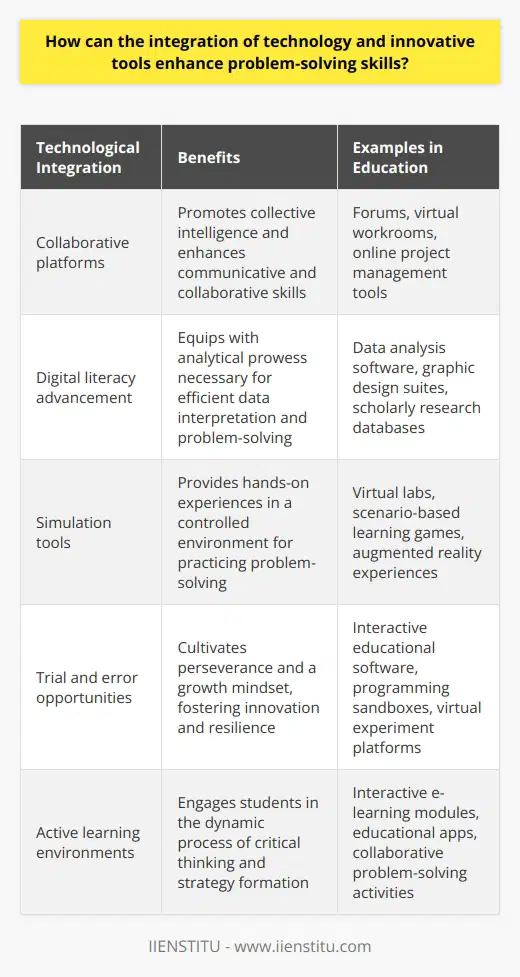
How does developing emotional intelligence contribute to effective problem-solving and decision-making?
Understanding Emotional Intelligence
Developing emotional intelligence (EI) is a crucial aspect in enhancing an individual's problem-solving and decision-making skills. Emotional intelligence encompasses the ability to recognize, understand, and manage emotions, which helps in effectively processing information, managing stress, and improving interpersonal relations. When these abilities are refined, it positively influences not only the individual's personal well-being but also their capacity to navigate complex situations effectively.
Recognizing and Understanding Emotions
One way EI contributes to problem-solving is through recognizing and understanding emotions. Individuals with high emotional intelligence can identify and comprehend their own emotions, as well as the emotions of others. This leads to empathetic communication and clearer perspectives when faced with challenges. Furthermore, this recognition allows for an improved understanding of team dynamics, ultimately enhancing the collaborative problem-solving process.
Managing Emotions
Emotional intelligence also plays a vital role in regulating emotions during decision-making. The ability to manage emotions effectively allows individuals to keep their stress levels in check, reducing the chances of impulsive decisions. High emotional intelligence enables an individual to withhold judgment, maintain objectivity, and refrain from emotional biases, leading to more rational decision-making. Moreover, emotional self-regulation allows individuals to evaluate their responses in various scenarios, consequently refining their strategies and enhancing problem-solving abilities.
Effective Communication and Collaboration
In addition to individual benefits, developing emotional intelligence plays a significant role in fostering effective communication and collaboration within teams. By understanding and acknowledging the emotions of others, empathetic connections are formed, allowing for a deeper understanding of diverse thought processes. This understanding leads to better collaboration in problem-solving as it promotes idea-sharing, critical thinking, and a balanced evaluation of different perspectives. Furthermore, these connections lower the chances of misunderstanding and conflicts, enabling the team members to work cohesively towards their goals.
In conclusion, developing emotional intelligence provides a significant advantage in the realms of problem-solving and decision-making. It enables individuals to recognize and understand emotions, manage them effectively, and facilitate strong communication and collaboration. As a result, individuals with high emotional intelligence are better equipped to handle complex situations, make well-informed decisions, and navigate the intricacies of interpersonal relationships.
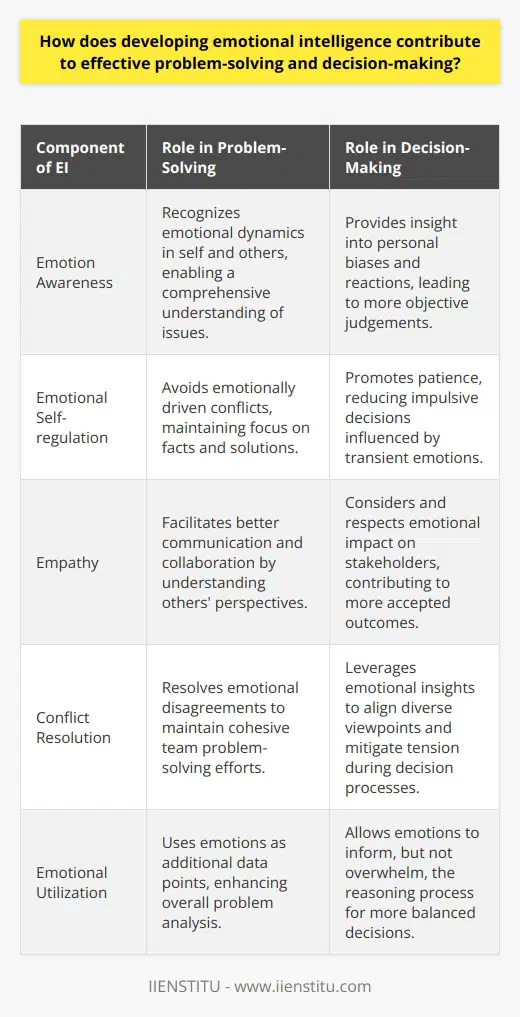
What are the cognitive and behavioral skills that contribute to effective problem-solving?
Cognitive Skills in Problem-Solving
One crucial aspect of effective problem-solving involves cognitive skills, which refer to mental processes associated with thinking, reasoning, and perception. Key cognitive abilities that facilitate successful problem-solving include critical thinking, working memory, and information processing.
Critical thinking
Critical thinking is the ability to analyze information objectively and make informed judgments based on evidence. It involves breaking down complex problems into smaller parts, assessing the relevance and credibility of information sources, and considering various perspectives when evaluating a problem. This skill aids individuals in identifying the root cause of an issue and developing practical remedies.
Working memory
Working memory is essential for retaining and manipulating information in the short term, which aids in mental calculations and decision-making. Working memory contributes to successful problem-solving because it facilitates the examination of various solutions simultaneously, as well as the retention of relevant data while discarding irrelevant details.
Information processing
Information processing refers to the ways individuals receive, interpret, store, and retrieve data. Effective problem-solvers are skilled in processing large amounts of information, organizing it, and identifying patterns or relationships that may provide insights for resolving the issue at hand.
Behavioral Skills in Problem-Solving
Behavioral skills, on the other hand, involve patterns of action and observable aspects of personality that influence an individual's response to a problem. Notable behavioral skills for successful problem-solving include adaptability, communication, and self-regulation.
Adaptability
Adaptable individuals can adjust their approaches and tactics when faced with new information or changes in circumstances. This flexibility is vital for effective problem-solving as it allows individuals to modify their strategies, overcome obstacles, and respond to feedback constructively.
Communication
Clear and concise communication enables problem-solvers to collaborate with others, convey their ideas, and seek assistance when necessary. By expressing their thoughts and concerns effectively, problem-solvers can facilitate a mutual understanding with others, which can lead to shared solutions and better results.
Self-regulation
Lastly, self-regulation is the ability to monitor and control one's emotions, thoughts, and behaviors during the problem-solving process. Effective problem-solvers are adept at managing stress, maintaining focus, and persevering through challenges. Mastery of self-regulation allows individuals to navigate complex problems without becoming overwhelmed or making impulsive decisions.
Overall, both cognitive and behavioral skills contribute to effective problem-solving by enabling individuals to analyze problems, generate and evaluate optimal solutions, and execute those solutions until the desired result is achieved. Developing and refining these skills can enhance one's problem-solving abilities and ultimately lead to greater success in various life domains.
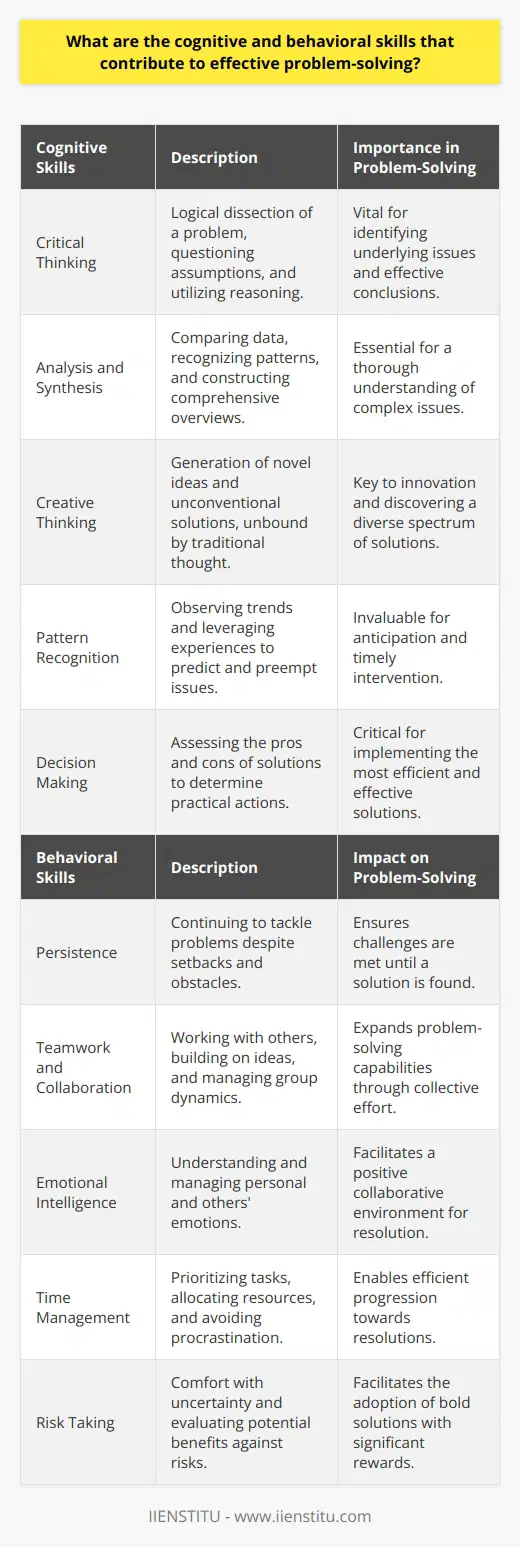
Which techniques can be employed to overcome cognitive biases in problem-solving?
Techniques for Overcoming Cognitive Biases
Eliminating cognitive biases in problem-solving is crucial for better decision-making. Various techniques can be employed to overcome these biases, which eventually lead to improved problem-solving skills.
Active Open-mindedness
To start, active open-mindedness is essential. Being aware of cognitive biases and the potential for biased thinking can facilitate a more objective evaluation of information. Embracing alternative perspectives, questioning assumptions, and openly considering conflicting data can significantly reduce the influence of cognitive biases.
Analyzing Mental Processes
Additionally, analyzing one's mental processes, also known as metacognition, is another effective technique. Through metacognition, individuals can evaluate the quality of their thought processes, identify their biases, and seek to minimize their impact. This continual reflection and self-assessment can lead to more accurate problem-solving.
Breaking Down Biases
Furthermore, breaking down biases into specific components promotes a deeper understanding of the issues at hand. Identifying the root cause of a bias and dissecting its elements can shed light on previously unnoticed influences, ultimately assisting in overcoming these biases effectively.
Seeking Diverse Perspectives
Incorporating diverse perspectives from individuals with varying backgrounds and expertise can also help reduce cognitive biases. By consulting with others, one can benefit from collective knowledge and different experiences, gaining a broader viewpoint and enhancing decision-making.
Understanding Base Rates
Understanding base rates is critical for overcoming cognitive biases. Base rates provide objective background information that can assist in contextualizing and comparing data. An awareness of these rates can reduce the likelihood of falling victim to certain biases, such as the representativeness heuristic.
Decision-making Frameworks
Lastly, employing decision-making frameworks can aid in overcoming cognitive biases. These structured approaches to problem-solving and decision-making offer a systematic and organized method for processing information, thereby reducing the influence of cognitive biases. Examples of such frameworks include decision trees, multi-criteria decision analysis, and the Delphi technique.
In conclusion, overcoming cognitive biases in problem-solving necessitates a combination of active open-mindedness, metacognition, breaking down biases, seeking diverse perspectives, understanding base rates, and employing decision-making frameworks. By adopting these techniques, individuals can significantly improve their decision-making abilities and enhance the quality of their problem-solving.
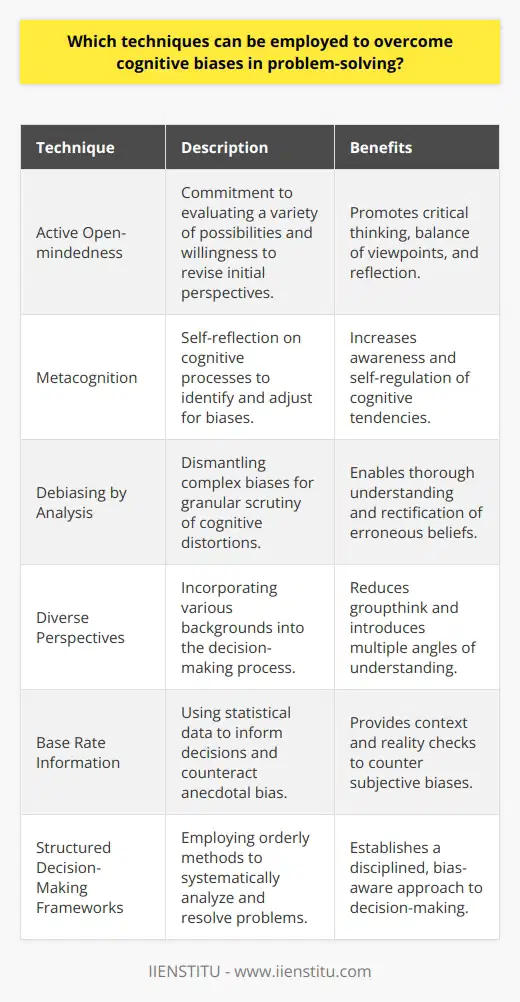
How does the practice of metacognition benefit the problem-solving process?
Enhancing Problem-Solving Skills
The practice of metacognition plays a crucial role in improving problem-solving abilities by fostering awareness, reflection, and adaptability in the cognitive process. Metacognition involves actively monitoring and managing one's thinking, enabling individuals to assess the effectiveness of their strategies, make critical judgments about new information, and identify areas for improvement (Livingston, 1997). This self-regulated learning approach promotes the acquisition, retention, and application of newly acquired knowledge and skills required for complex problem-solving contexts.
Facilitating Optimal Strategies Selection
Through metacognition, learners develop the capacity to select appropriate problem-solving strategies based on the characteristics of a given task. By assessing the requirements of a problem and drawing upon prior experiences and existing tactics, individuals can identify and implement suitable approaches (Anderson, 2009). This process facilitates adaptive thinking while minimizing inefficiencies caused by the overuse of ineffective techniques.
Enhancing Critical Thinking
Metacognitive practices aid in the development of critical thinking skills, which are fundamental for deep, meaningful understandings of subject matter. These skills are essential in problem-solving tasks as they enable learners to analyze information, evaluate alternative solutions, and synthesize new ideas (Petty, 2009). As a result, metacognition assists in the cultivation of cognitive flexibility, resilience, and creative problem-solving strategies.
Developing Self-Monitoring Skills
An essential aspect of metacognition is the ability to monitor one's cognitive processes while problem-solving. This self-monitoring skill allows learners to track their progress, identify potential obstacles, and adjust tactics accordingly (Cubukcu, 2012). By enhancing self-awareness and self-regulation, individuals can become adept problem solvers who are capable of adapting to challenging situations.
Promoting Effective Planning
Metacognition encourages the development of planning skills, which are crucial for establishing goals, prioritizing tasks, and allocating resources during the problem-solving process (Kuhn, 2000). By effectively planning, individuals can create clear objectives, anticipate potential difficulties, and devise contingencies, increasing their likelihood of achieving desired outcomes.
In conclusion, metacognition significantly benefits the problem-solving process by cultivating critical thinking, promoting strategic selection, enhancing self-monitoring, and fostering effective planning. By incorporating metacognitive practices into learning environments, educators can empower students to become skilled, adaptable, and resilient problem solvers, prepared for the complex challenges of the 21st century.
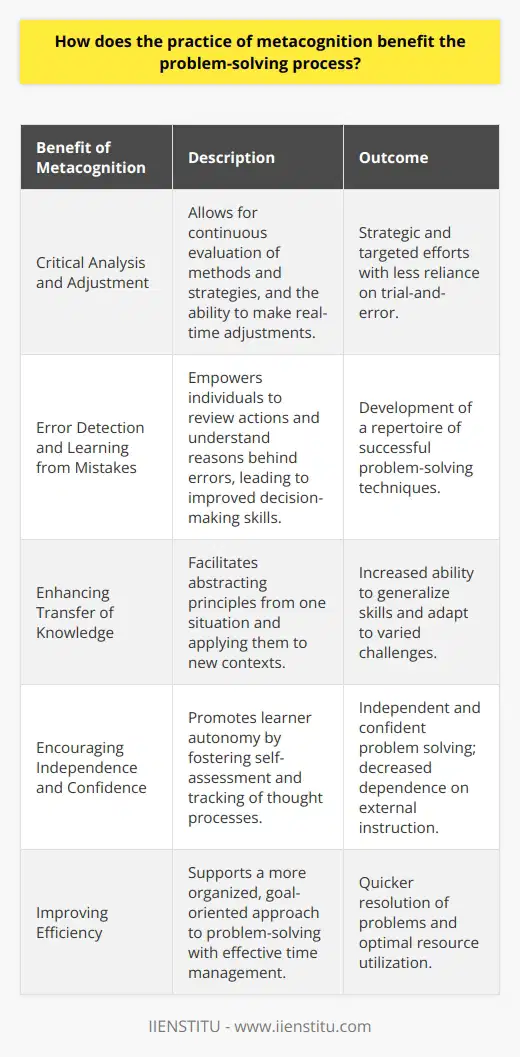
What are some best practices for fostering creativity and adaptability in problem-solving?
Fostering Creativity in Problem-Solving
One potential approach for fostering creativity in problem-solving involves embracing divergent thinking, which encourages individuals to explore various possibilities and generate multiple ideas. This can be achieved through brainstorming sessions, where participants are prompted to think outside the box while postponing judgment, allowing for a free flow of ideas. By cultivating an environment that supports and values creative thinking, individuals are more likely to take risks, experiment with novel approaches, and ultimately arrive at innovative solutions.
Promoting Adaptability in Problem-Solving
In order to develop adaptability in problem-solving, it is essential to provide opportunities for learning and skill development. Encouraging individuals to engage in continuous learning, perhaps through training programs or workshops, can contribute to a growth mindset and prepare them to adapt to new and unanticipated problems. Emphasizing the importance of flexibility, open-mindedness, and the recognition that failure often leads to valuable insights can further enable individuals to navigate the unpredictable problem-solving landscape more effectively.
Collaborative Problem-Solving
Collaborative problem-solving offers another avenue for cultivating both creativity and adaptability in problem-solving. By nurturing a collaborative culture where diverse perspectives and experiences are valued, organizations can unleash the collective intelligence of their teams to generate more innovative solutions. Enabling efficient communication, promoting mutual respect, and fostering trust among team members can improve the effectiveness of collaborative efforts and yield more creative and adaptable problem-solvers.
Iterative Processes for Problem-Solving
Finally, the incorporation of iterative processes such as design thinking and agile methodologies can foster both creativity and adaptability in problem-solving. These methods emphasize the importance of experimentation, prototyping, and continuous iteration based on user feedback, allowing potential solutions to be refined, optimized, and adapted over time. By adopting such iterative and user-centered approaches, individuals and organizations can become more adept at addressing complex and evolving problems with creative and responsive solutions.

How can various communication styles impact the effectiveness of problem-solving techniques?
Analyzing the Influence of Communication Styles
Effective problem-solving requires clear and precise communication between all stakeholders. The manner in which information is conveyed, known as the communication style, can greatly impact the efficiency of problem-solving techniques. Understanding how different communication styles can influence the process is crucial for effective collaboration and successful outcomes.
Assertive Communication for Clarity
Assertive communication is characterized by transparency, directness, and openness. When individuals communicate assertively, they express their thoughts and feelings honestly and effectively. This style fosters an environment where participants feel comfortable sharing their ideas and feedback. Assertiveness enables efficient communication, which leads to the implementation of more reliable and effective problem-solving techniques.
Passive Communication Poses Risks
Contrastingly, passive communication often compromises the effectiveness of problem-solving techniques. Those who rely on this style typically avoid direct confrontation and may not clearly express their thoughts or feelings. As a result, pertinent information remains unshared, leading to misinterpretations and miscommunications. Consequently, the problem-solving process becomes fraught with inefficiencies and possible errors.
Aggressive Communication: Obstructing Collaboration
Aggressive communication hinders problem-solving, as evident from its confrontational, dominating, and disrespectful nature. When individuals employ this style, they risk overshadowing the ideas of others and stifling open dialogue. The negative emotions that aggressive communication evokes can disrupt the collaborative atmosphere, often leading to a breakdown in communication and a suboptimal resolution of the issue at hand.
Impact of Organizational Culture
It is essential to consider the organizational culture when assessing the influence of communication styles on problem-solving techniques. In an open and transparent culture, assertive communication is typically encouraged, which consequently allows for effective problem-solving. Meanwhile, organizations that foster passive or aggressive communication behaviors may need to address these issues by implementing training and development initiatives to strengthen assertive communication skills among their staff.
The Path Towards Improved Problem-Solving
Recognizing varied communication styles and their impact on the effectiveness of problem-solving techniques can help foster an environment conducive to successful collaboration. By promoting assertive communication and addressing the risks associated with passive and aggressive styles, organizations can enhance their problem-solving processes, improve team dynamics, and achieve more meaningful outcomes.

Can you provide some examples of real-life situations in which a systematic approach to problem-solving led to successful resolution?
Examples from Business and Healthcare
A systematic approach to problem-solving can be highly beneficial in various real-life situations, as demonstrated by the following examples from business and healthcare sectors.
Software Development and Agile Methodology
In the software development industry, one widely-used approach is the Agile methodology. This systematic process separates projects into small, manageable tasks called sprints. By tackling one sprint at a time, teams can better identify potential roadblocks, adapt to changing requirements, and ensure the development of high-quality products that meet customer demands (Fowler & Highsmith, 2001).
Lean Management in Manufacturing
In the manufacturing sector, the Toyota Production System (TPS), also known as Lean management, has provided a stellar example of employing a systematic approach to problem-solving. At its core, TPS aims to minimize waste and optimize resource utilization through continuous improvement (Liker, 2004). By systematically identifying and addressing inefficiencies, Toyota has ensured better production quality, enhanced customer satisfaction, and a competitive advantage in the global market.
Six Sigma and Process Improvement
Another important example from the business world is the Six Sigma framework, which focuses on reducing variation and eliminating defects in processes. Companies like General Electric and Motorola have successfully adopted this systematic approach to improve customer satisfaction, reduce product defects, and achieve better financial performance (Harry & Schroeder, 2000).
Clinical Decision-Making in Healthcare
In healthcare, a systematic approach to problem-solving is vital for accurate clinical decision-making. By carrying out a comprehensive patient assessment, healthcare professionals can correctly diagnose medical conditions, develop treatment plans, and ensure better patient outcomes (Croskerry, 2009). This approach reduces medical errors and enhances the overall quality of care.
Conclusion
These real-life situations exemplify how a systematic approach to problem-solving has led to successful resolutions in various sectors. The Agile methodology, Lean management, Six Sigma, and clinical decision-making processes showcase the diverse applicability of systematic problem-solving strategies in addressing complex issues, improving organizational performance, and ultimately, enhancing customer satisfaction.
References
Croskerry, P. (2009). Clinical cognition and diagnostic error: Applications of a dual process model of reasoning. Advances in Health Sciences Education, 14, 27–35.
Fowler, M., & Highsmith, J. (2001). The agile manifesto. Software Development, 9, 28-35.
Harry, M. J., & Schroeder, R. (2000). Six sigma: The breakthrough management strategy revolutionizing the world's top corporations. Currency.
Liker, J. K. (2004). The Toyota way: 14 management principles from the world's greatest manufacturer. McGraw-Hill.
